| NEWS |
|
|
| BADGES |
|
|
| ROMFORD DISTRICT |
|
|
| FEATURES |
|
|
| SONGS |
|
|
| FORMS |
|
|
| LINKS |
|
|
| WEB SITE |
|
|
|
 |
 |
1940 |
|
|
Despite not being allowed to meet in the Church Hall throughout the Second World War, not one Troop or Pack meeting was cancelled and training standards were improved upon. The first Bushman's Thong gained in the present Romford District was obtained by the Troop Leader (Senior Patrol Leader) in March 1940.
A Bushman's Thong was awarded to First Class Scouts who hold the Camper badge, together with one of the following: Explorer, Stalker, or Tracker, and also one of the following: Forester, Naturalist, Pioneer, Starman, Weatherman. The Bushman's Thong, consisted of a leather thong on the right shoulder.
The Essex County Handbook for 1939 (published after the November AGM) contains the following Report for Romford District.
|
|
After war had began, many groups could not meet at their H.Q. so use was made of local camping grounds for combined scout activities and games. Day and night messenger service being maintained and duty at First Aid Posts. The Council has expressed appreciation several times for the services being performed. Credit is due to Mr. W. L. Payne, A.D.C. as Officer in Charge, for the hard work put in. Senior Scouts and Rovers man the report centre on Saturdays and Sundays to relieve normal staff. No evacuation (Neutral Area).
|
|
|
F. Rowswell noted in his notes The 3rd Gidea Park Scouts did not wait for the District Organiser to find Civil Defence jobs for them - before the town hall messenger service was devised, 3GP Scouts were already helping First Aid posts and Warden Posts.
The following is an extract from our 1940 annual report and gives an idea of what life was like for the young occupants of Gidea Park during 1940.
|
|
For most of the year we were generously accommodated in one suitable den or another by the late Dr. Levy whom we shall always hold in grateful memory. But the Nazis must have copied our address-book for they dropped bombs outside the homes of nine of our members (almost inside one of them) and at last bombed us out of our temporary den. For some time we were obliged to meet under canvas roofing within patched walls but at length the generosity of Mr. Coward secured us a new den, which is now in regular use.
Up to the time of our Summer Camp we carried out our normal training and our numbers, particularly in the Cub Pack, increased considerably. But later on, air-raids and black-out combined to diminish attendance at meetings, especially in the Cub Pack. Membership of such absentees is reckoned still but on an honorary basis; even so, we can claim better attendances than in September 1939.
Our Scout spirit is unquenchable and we carry on much as before. We believe ourselves to be the only Troop in a very wide area which still meets in the evenings; we disperse at the call of the siren, and rush home before the bombs fall.
Communication with Scouts who have been removed elsewhere is kept up by the dispatch of the "WAR-TIME WOGGLE" a monthly news bulletin for such exiles. News is also published as often as possible in the weekly paper "THE SCOUT", which is now purchased regularly by each patrol.
|
|
|
The Scout was a weekly national newspaper for Scouts. The 1940 annual report also mentions that 3GP Patrol Second Peter Hunt had been made Editor's Representative of "The Scout". Peter was also promoted to the role of Patrol Second of the Woodpigeon Patrol. Eric Sheppard became Patrol Leader of the Woodpigeons while Doug Pyne became Troop Leader which appears to be akin to a modern Senior Patrol Leader. More about those Scouts later.
The report goes on as follows:
|
|
Our seniors have given much of their time at the Report Centre but some (including juniors) have found more dangerous jobs to their liking and have joined Wardens' Posts, First Aid Posts and Stirrup Pump Crews. Others dig for victory and breed poultry. Hedges and backyards adjoining our den have been cleared for scrap metal, a rich harvest ensuing. Several Scouts camped at Navestock in August to help gather the fruit harvest and one of them also collected fragments of mangled Messerschmidt as well which he then exhibited for the local Spitfire fund, thereby raising many pence. One of our younger exiles, unable to find a Scout Troop has joined the local Home Guard as a messenger.
The Old Wolf [F. Rowswell] spends daylight hours as "Spotter" and at night tours the neighbourhood in search of air-raid casualties, occasionally stopping for an hour or two, to dig victims out of ruins. One recent evening he saw a house blow up through enemy action. It was next door to Peter, Tony and Brian Buckler, to whom we send our sympathy for their wrecked home. |
|
|
The report also mentions two April camps, one at Thorrington and the other for a single day at King Edward VIII near Danbury.
|
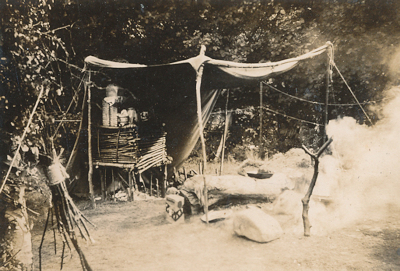
A CAMP KITCHEN - SUMMER CAMP 1940
|
The summer camp in Wales was visited twice by the Deputy Camp Chief of Wales who reported in these words: "A very Scoutlike site and a very Scoutlike camp. On both occasions I found everything spotless and in apple-pie order. The boys spent their whole time on Scout work, and were always well-behaved and properly dressed when outside boundaries. I consider this one of the best Scout camps I have ever seen."
|
|
Finances.
Group finances were depleted by the end of 1940 with the Group making a loss that had to be guaranteed by F. Rowswell. This loss was put down down to the following:
- Expendature on a camouflage proofing solution for the tents.
- The unexpected high cost of food on camp in Wales.
- Spending money on new lighting and heating equipment for our new meeting place.
|
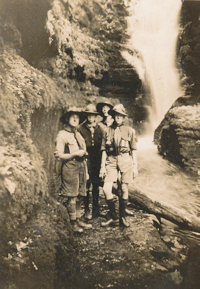
Craig-T-Pwll-Du
|
|
|
. |
|
|
 |
 |
|
 |
 |
 |
MEETING PLACES DURING THE WAR |
|
|
When the War broke out in September 1939, the 3rd Gidea Park had to find a new place to meet. In September 1939, the troop moved into stable lofts at the back of “Beverley” 69 Main Road, kindly put at our disposal by the late Dr. Victor Levy, father of one of our PLs. This was soon given up to a city firm for goods storage, and the Troop then met in the public air raid shelter under the house. When air raids began in earnest in September 1940, the troop held evening meetings in a small shed behind the house.
Tuesday after Tuesday, a few Scouts would come for their Troop meeting, dashing home as the air raid siren sounded. But one night a High Explosive bomb dropped next door demolishing that house completely and with it, the shed at the rear of “Beverley”
|
|
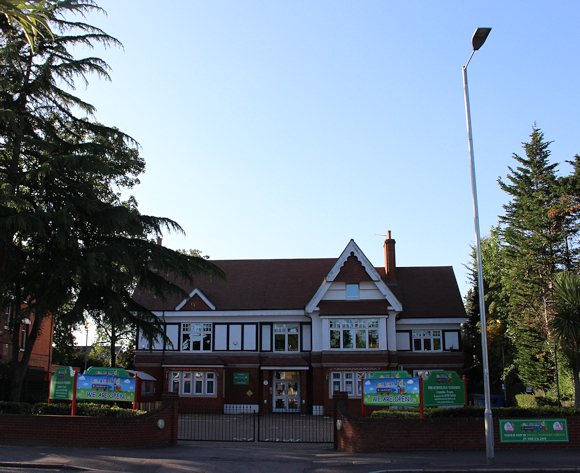
69 Main Road is now a nursery.
|
|
The Scouts next took an empty garage near the railway station provided by the generosity of one of the PL's grandparents. At last an improvement set in for the enemy ceased air raids on Tuesdays and no meeting in that garage was ever stopped by an air raid.
|
|
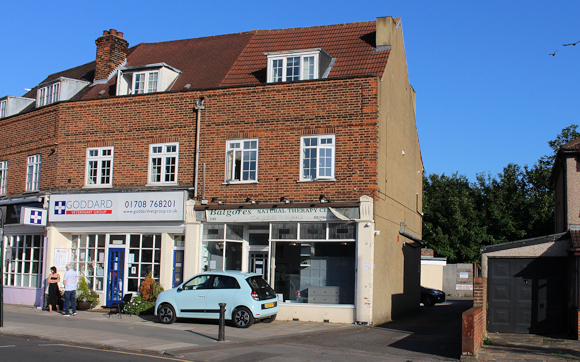
Shops on the corner of Carlton Road and Balgores Lane
|
|
In 1943 the owner brought a car and so unable to use the garage the Troop moved to an old wooden schoolroom near Harold Wood Hall (on the other side of the A12 to Gallows Corner Tesco).
|
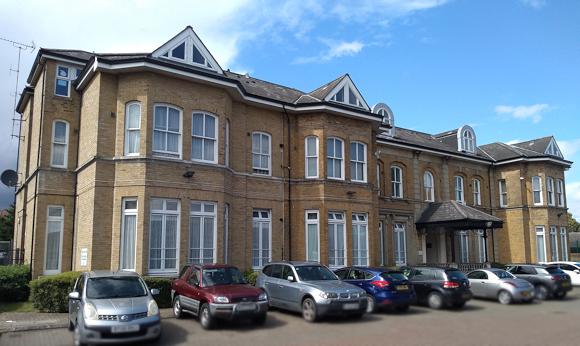
HAROLD WOOD HALL - 2020
|
|
In the winter of 1943, a further move was made to Salisbury Rd School which could be booked out for evening meetings. (By this time 1st GP had moved to Arnaud Lodge.) Eventually the Chadwick Hall was restored for use, and the nomadic Group welcomed back triumphantly.
|
|

MAP NOT AT ALL TO ANY KIND OF SCALE
|
|
|
 |
 |
|
 |
 |
 |
PETER R HUNT |
|
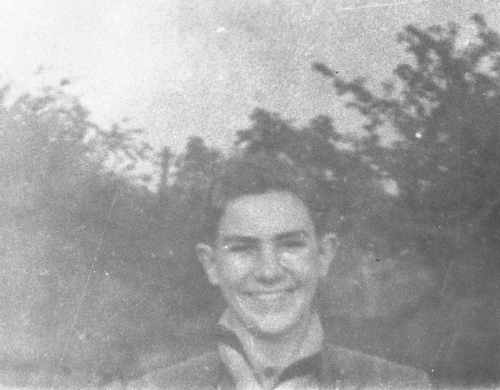
|
|
Peter R. Hunt died on August 14th 2002 at his house in Santa Monica, California at the age of 77. His obituary in the Guardian Newspaper notes that his first claim to fame was appearing on a recruiting poster for the Boy Scouts Association when he was 16. His entry in the jamesbond.fandom.com wiki also notes he was "a very avid Scout".
With the details in our Group archives we are able to elaborate on the Scouting aspect of Peter’s early life.
According to 3rd Gidea Park’s first register of Scouts, Peter Edward Roger Hunt was born on March 11th 1925. He was the 35th boy to register as a member of the 3rd Gidea Park Troop. He passed his Tenderfoot test on October 29th 1937 which would have allowed him to become invested aged 12. He joined the Woodpigeon Patrol. His younger brother Derek Hunt joined the 3rd Gidea Park Cubs.
Peter attended the April camp in Switzerland in 1938 and the infamous 1938 summer camp at Great Towers that resulted in a camp site being named Gidea Glade for at least 20 years. He also completed his 2nd class tests in July 1938.
In 1939 he attended the camp in Pau, France but also started working in the Imperial Scout Headquarters Shop in London at the age of 14. It was almost certainly this that led to him appearing on a promotional poster for the Scouts.
During 1940 he attended the summer camp in Wales and is mentioned in the Group annual report as being made the Assistant Patrol Leader of the Woodpigeons patrol. He was also appointed as an editor’s representative to the weekly paper, THE SCOUT. At that time, he is also listed as an Assistant Cub Master. He moved house a lot while living in Gidea Park but then a lot of our Scouts did due to bomb damage. Our records have him living in Severn Avenue, then Heath Drive and finally Pettits Lane. Peter was made Secretary of the troop in 1941.
Peter’s uncle made government training and educational films and it was he that gave Peter an interest in films and started to teach him some filmmaking skills. During 1941 along with Tony Levy and Alan Rowe, Peter helped promote the local film week. During our Summer Camp that year he was one of a small number of Scouts who hiked 27 miles in a single day across the Lake District.
The October 23rd, 1941 issue of THE SCOUT contains an article by Eric Merriman based on a story he extracts from "My pal at Headquarters-Peter Hunt." The article describes members of 3rd Gidea Park sleeping without tents on the summit of Scafell Pike during summer camp. This seems to have prompted at least two further mentions in THE SCOUT as other members of the movement write in to relay their experiences of camping on that summit.
Peter wasn’t listed as a Cub Master in 1943, but was listed as an Assistant Scoutmaster in our second troop register with no start date but the first entries in that register are 1942. There is no date of warrant and his entry was updated to state he was away on Active Service. During 1943 photoes of him and other members of the Troop felling trees in Jermayn's Wood (Between Tyler's Common and the M25) were published in an article about English Scouting in the American Scouts' magazine "Boy's Life".
A note about him in the Group archives states that he had intended to join the army film unit but it seems the army regarded him as too healthy and fit for that so he trained as an infantryman. A troop newsletter dated November 1943 mentions him as "now L/c, (Lance corporal) with an O.C.T.U. (Officer Cadet Training Unit) in view." One of his early deployments was to Italy for the Battle of Cassino. Some sources say he returned to Italy immediately after the war to study but never completed his course, instead returning to work with his uncle.
In the Group's 1948 annual report Peter is mentioned as one of many contributors to the production of David Lean’s “Oliver Twist” although IMDB does not mention him.
He worked his way from cutter, assembling editor, supervising editor and editor. In 1961 he was editing a movie called On The Fiddle starring Alfred Lynch and Sean Connery. While out to dinner with the producer of On The Fiddle, he bumped into film producer Harry Saltzman, who was then conducting the 007 casting search. Hunt suggested Connery for the part which led to Saltzman looking at some footage. The rest, as they say is history although Saltzman’s producing partner Cubby Broccoli had also spotted Connery in a screening of Walt Disney's Darby O'Gill and the Little People.
Peter really made his name when he signed on as editor on Dr No, the first James Bond movie. He established a new fast paced editing style which helped establish the Bond franchise. He edited the first three Bond movies and started some second unit direction on Goldfinger. He did some more 2nd unit directing on two more Bond movies as well as directing the title sequence of Chitty Chitty Bang Bang before taking on the role of Director for On Her Majesty’s Secret Service.
3rd Gidea Park’s 1993 Queens Scout Expedition passed within a mile of Piz Gloria, the mountain top restaurant made famous as Blofeld’s base in the film, On Her Majesty's Secret Service. Everywhere we hiked, we saw posters for the "James Bond Restaurant." Had we known that the film that made it famous was directed by a 3rd Gidea Park Scout we would have made the effort to visit.
In our archive there is half a page from an unknown document titled Famous Personages :- 2 P. Roger Hunt. The picture at the top of this section is from that page. We don't know who the other famous personages were? An extract from the text of that page which was probably written by Mr Rowswell is as follows:
|
He has always been well known for his "Film Star Appearance". Unfortunately he is likely to be called up soon for the Army Film Unit, but in the true Peter Hunt manner he will often pop in on us unexpectedly (we hope). |
|
|
|
 |
 |
|
 |
 |
 |
1941 |
|
|
In 1941 the troop included seven King's Scouts. Increases in numbers occurred in both Cubs and Scouts. Many other local troops ceased to meet so their members would come over to this troop, swelling the numbers to the limit of capacity. At times the 3GP was the only Romford District Troop still meeting.
The annual report for 1941 was written by Mr Rowswell and Peter Hunt in his capacity of Group secretary. It opens with the following. |
| For some strange reason the enemy ceased bombing us on Tuesday evenings and we were able to hold our meetings throughout the air raid season, with only one interruption. (Perhaps Rudolf Hess can explain). By way of compensation they wrecked our houses on various other nights, so that eight of us have now lost our homes, while hardly anyone has escaped damage. But we put up with it, smiling and whistling, determined that these things are sent to try us. |
|
It goes on to explain that the Troop's summer camp was mentioned in "The Scout" and the Romford Times. The Scouts hiked from their base camp at Wray Castle the 10 miles to Scafell Pike where a group of them slept under the stars on the summit. This prompted a lengthy chain of correspondence in "The Scout" from other Scouts who had done the same.
Three sub camps were formed each under the charge of a Gold Chord Scout as Acting Assistant Scout Master with one or more Kings Scouts as Sub-Camp-Chief. Over 100 miles of hiking was completed including one partrol who hiked to Great Towers and discovered that the site we had used in 1938 was now officially named "Gidea Glade". Two Scouts, David Walker and Peter Hunt hiked 27 miles in one day. The group even spent a night camping with the South Weald Scouts at Dungeon Ghyll.
The Troop also camped at Danbury at Easter and Ockenden at Whitsun.
The 1941 Annual report also contained the sad report of Robert Whitaker’s passing. At the age of just 19 he had lost his life during flying practice at Montrose. The Scouts attended his memorial service at St Michaels. Robert had been a Scout and Patrol Leader at 3GP since 1934.
NATIONAL SERVICE
Most of the older Scouts were working as fire-watchers or report centre messengers. Some worked at First-aid posts or wardens posts. Tony Levy had become an Assistant Gas Detection Officer. Tony also led a large group of our Scouts in forestry work at Germain's Wood.
The Cubs and younger Scouts picked fruit for a local jam making centre and 48kg of dried nettle leaves for drug making. Two of our Scouts, Eric Sheppard and Derek Leggett appeared in “The Star” doing forestry work. A patrol of Scouts had been formed to erect indoor air-raid shelters in Gidea Park and F. Rowswell was still a member of the First Aid team.
A glowing account of John Milner’s efforts in rescue operations when his own and his neighbour's houses were destroyed in an air raid appeared in the press in March. David Walker, Tony Levy and Alan Rowe were noted as being particularly successful in the prompt extinction of showers of explosive incendiaries.
The 1941 report also mentions a Scout described as “our heavyweight” Derek Leggett. He refused to abandon his fire watching post when a parachute mine exploded 30 yards from his post. The mine won the altercation blowing Derek through his garage. He didn’t let it worry him, picked himself up and began to help in the rescue. Doug Pyne also helped extricate victims from the rubble.
By the end of 1941 we had 36 Scouts and 40 Cubs, too many to fit in the small garage so we had to prevent further members joining. The 1941 annual report closes with the news that "The Old Wolf" (F. Rowswell) was being called up leaving 3rd Gidea Park with no Leaders.
INFLUENCE AT DISTRICT
In 1941 the Romford Local Association (District) executive committee consisted of 80 members and bore little resemblance to that prescribed in POR. This became particularly inefficient once war broke out since very few members ever attended consecutive meetings. Mr Rowswell complained regularly about the executive on the subject of the testing and training of Scouts. Mr Rowswell was eventually invited by the then chairman to attend a meeting. That experience seemed to confirm Mr Rowswell’s suspicions. He subsequently advised the then DC to dissolve this executive somehow and re-shape it properly. A Motion was introduced and passed by which all except legally ex-officio members resigned and only the requisite number sought re-election. Thus the District executive in its current form was duly constituted, and the previous chaotic state of affairs brought to an end.
|
|
|
 |
 |
|
 |
 |
 |
ERIC SHEPPARD |
|
|
If you walk down Castellen Avenue in Gidea Park, as the road turns the corner, you may notice that numbers 54 and 56 are of a more modern design to the surrounding houses. This is the area that Eric Sheppard lived in up until May 11th 1941.
Eric Sheppard was born on 26/2/1926. He joined Cubs July 1934 and transferred to the Scouts in June 1937. He was a Patrol Leader by 1941.
Shortly after midnight on May 11th 1941 a parachute mine fell on the Sheppard family's air raid shelter destroying it completely.
Fortunately none of the family were in the air raid shelter but their house and others nearby were severely damaged or destroyed. Eric's mother was up as she was about to go out on fire watching duty. She escaped being buried but was hospitalised by cuts from flying glass.
Eric was in bed when the bomb struck but managed to escape from the wreckage of his house bere foot wearing only his pyjamas. Without any thought for his own safety he set to work trying to clear the rubble from the collapsed part of his own house. Some neighbours soon arrived to help as did F.W. Rowswell who lived at 1 Ferguson Ave and may have been on duty. Eric directed them in their work under the dangers of a long and heavy air raid until both his sister and father were recovered without injury. All this time Eric worked with bare hands and feet removing the rubble of his house. All without tools and all without regard to cuts sustained to his face. After his family and pets were recovered he then went on to assist the recovery next door.
Only once his parents had been taken away for treatment and he had recovered all his pets (including a monkey) did he find clothes for himself before making the journey to the rest centre.
The following morning he returned home and helped by other members of the Scout Troop he led in the operation to recover his family’s belongings.
There was only one fatality that night, Walter Whittaker – who is commemorated on the St Michaels Memorial Board.
For his efforts and attitude that night, the Scout Association Awarded Eri the Silver Cross for Gallantry. This award is currently described as "The Silver Cross, with a blue ribbon and emblems or brooches corresponding to them, is awarded for gallantry in circumstances of considerable risk."
Eric’s exploits that evening and subsequent awards were covered in great detail, by several local papers.
On Sunday October 19th 1941 a Scout's Own service was arranged at St Edwards School with over 300 guests. As well as the Mayor of Romford, it was attended by the County Commissioner Major R. Magor (who was also the Deputy Lieutenant of Essex) who presented Eric with his Silver Cross. Also in attendance were town councillors, District officials including the DC as well as the DC of at least one other District.
On October 28th the Town Clerk Mr J. Twinn who was an Honouree Commissioner visited the Troop to award a special presentation to Eric Sheppard on behalf of the Romford Local Association.
A month after the bomb, in June 1941, Eric came 3rd in the Open High Jump in the District Scout Sports. Later that summer Eric attended summer camp and was one of the small band of Scouts to camp over night on top of Scafell Pike with no tents. He is mentioned in the November 1943 troop newsletter as being a "Deep Sea Scout, selected after good training results for a probable commision at Shotley." In the February 1944 newsletter he is mentioned as having survived his first cruise with the Royal Navy in arctic waters during December. Eric was quoted as considering it "rather cold work to swab the decks barefoot in such weather." |
|
|
 |
 |
|
 |
 |
 |
1942 |
|
|
Up to March 1942, F.W Rowswell continued as the sole Scouter, running both Cubs and Scouts. When he was called to the forces at last, a Cub Master was found in the person of a Miss Chase, but for over a year there was no Troop Scouter with meetings being run by the Patrol Leaders.
Attempts to get the then D.C. W.G. Archer failed for the 7th Romford (Royal Liberty School) secured him instead. Miss Reid Wilson had moved away. Fortunately the Curate of St Michaels, Rev Hodgins kept a kindly eye and became so well trained under the PLs that when he moved to Chelmsford in 1943 he founded a flourishing Troop there.
F.W. Rowswell was stationed at Harpenden from August 1942 to June 1944 and was able to pay visits about every other week even cycling the 35 miles each way from the unit and back on Thursday Evenings.
THE ELITE COBRA PATROL
Another innovation was the formation of what is claimed to be the first Senior patrol in the UK. Four PLs being now all first class passed a self denying ordinance and constituted themselves the Cobra Patrol, this name was chosen so that the shoulder knot should be the colour of the Troop scarf and making this patrol the “elite core” of troop instructors. It was to be limited to ex. Patrol Leaders and ex Patrol Seconds who were first class Scouts. Eventually these Cobras were called up; successors were too busy being PLs and for some time the Patrol was in abeyance.
|
|
|
 |
 |
|
 |
 |
 |
1943 |
|
|
A CHANGE TO THURSDAYS
During 1943, Mr Rowswell contacted Mr T. England who was the chairman of the newly constituted Romford Youth Committee to see if he could find someone suitable to take over as a Scout Leader. Mr England found Mr T Robinson who was a former Group Scout Master of Bow District now living in Harold Wood. Mr Robinson was only available on Thursdays and so the meeting night changed and has stayed ever since. Mr Rowswell later wrote "Mr Robinson kept a faithful wise and beneficial eye on the troop until the I returned in 1945, although he did not take out a warrant."
SENIOR SCOUTS
In April 1941 the Chief Scout Lord Somers had announced a commission into post war developments. The results were published in the Scouter for comment in July 1942 and in May 1943 the Senior Scout scheme was published. As a result, in September of 1943 the troop was divided into two sections. Three patrols of senior Scouts of over 14 years of age and four patrols of Junior Scouts of under 14 years of age. The juniors met at Salisbury Road School on Thursdays from 6pm, the Seniors from 7:30. Mr Robinson looked after the juniors while the seniors looked after themselves with the assistance of Mr Rowsell who was still acting G.S.M. The acting Troop Leader was Ted Butcher and Harold Thorp was A.S.M.
In terms of numbers, the group was full with 50 Scouts and 40 cubs. In the November 1943 troop newsletter Mr Rowswell mentions correspendence from Scouts now in the service of thair country and stationed all over the world. He concludes with the sad news that Reg Clements (3rd Gidea Park Scout 1934-5) and Freddy Godwin (1st Gidea Park Scout 1933-8) had both lost thair lives in the Country's Service.
|
|
|
 |
 |
|
 |
 |
 |
1944 |
|
|
Our Cub Mistress, Miss Chase departed and the cub pack was suddenly handed over to Miss Joy Langmaid, then aged 18. Mr Rowswell initialy thought Joy was too young for a warrant as Cub Master, and totally unprepared for it. She had taken it on at very short notice having merely watched and helped for about three weeks. However as Mr Rowswell later wrote "under this keen lady’s vigilance and skill, perseverance and initiative, the pack flourished." Her Warrent as Cubmaster was issued on October 21st 1944. |
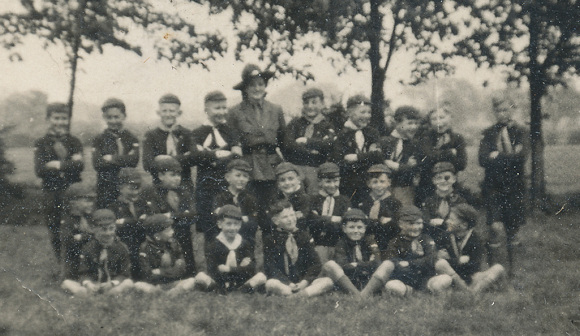
JOY WITH CUBS NOT ALL OF WHOM ARE WEARING 3GP SCARFS
|
In January 1944 the Group celebrated its tenth birthday with an event in the Wykeham Hall which was odd as the group wasn't registered until 1935 so this must have been the 10th anniversary of Scouting at St Michaels. The group’s stage show had been hastily revived for the event. A half column report appeared in the local press. The show ran for two and a half hours and included songs sang in English, French, Dutch and Swiss-Austrian.
By now the troop was meeting at Salisbury Road School but were often interrupted by air raids. They were meeting in a class room which didn’t give them much space but a better attendance that in 1940 was regularly achieved. For Scouts that couldn’t make the Thursday evening meetings we were also running meetings on Saturday afternoons. Reverent Howarth, Curate of St Michael’s was also helping with the running of the group.
The February 1944 troop newsletter reported the sad news that Nevil Armstrong had died in Canada whilst training for RAF flying duties. Nevil had been a member of the pre-war Peewit patrol and was one of the recipients of the “Order of the Second Steak” at Great Tower in 1938. |
|
|
 |
 |
|
 |
 |
 |
1945 |
|
|
In 1945, the troop leader, Edward Butcher, took out a warrant as ASM. So while Mr Rowswell was abscent in Europe the troop had two Scouters, and the cub pack one: a crowded state of Scouters unknown in peace time.
At the end of 1945, Mr Rowswell was released from the Army and found the group returned to its former home. In November 1945, there were just 20 Scouts, in 4 Patrols; of these only 5 were second class, none were first class and only 6 could swim. There was however no lack of keenness.
It was decided to tackle the hardest task first, that of the swimming. In November 1945, the first of the unbroken series of weekly swimming classes was held at the town bath, six years before the District Scout Swimming Club was revived. It was definitely prescribed that the class was for advancement in swimming, patrol points for attendance were only given if the scout improves on his standards. By 1947 nearly every Scout had become a swimmer and training in life saving had started. |
|
|
 |
 |
|
 |
 |
 |
1946 |
|
|
Early in 1946, T.Robinson left 3GP to revive the 2nd Harold Wood Cub pack at the London County Council Homes in Harold Wood Hall. 2nd Harold Wood had been originally founded in 1932 at Harold Court School. It was reeformed 1937 at Harold Wood Hall however the D.C. reported in 1942 “I found the boys in bed the last time I called officially”. It is unclear if the 2nd Harold Hill was active when 3GP was also meeting at Harold Wood Hall during 1943 but it was reported as closed in 1944 “due to evacuation”
E.Butcher was called up for the RAF and so once again the troop was down to one Scout Leader allthough the Group still had Joy Langmaid as the Cub Leader.
By 1946 Lord Somers scheme of senior patrols based on age only was found to be, in Mr Rowswell's words, "utterly wanting" and was ultimately abandoned. This enabled our elite Cobra Patrol to be reconstituted on its original basis of merit. Mr Rowswell commented that "Scouts are permitted to be leaders at the age when they are most capable of it, and young Scouts enjoy the tradition of a trustworthy and experienced senior."
The Group report for the year 1946 starts with a list of 7 members of 3rd Gidea Park who were called to higher service in the defence of their country.
|
| Reginald Clements |
Flight Sargent |
RAF |
Scout 1934-5 |
| Fred Godwin |
Lieutenant |
Infantry |
Rover Scout & Camp Assistant 1936-7 |
| David Lloyd |
|
RAF |
Scout 1934-5 |
| Donald Molyneux |
Corporal |
Infantry |
Cub 1934-5 |
| Wilfred Nicholass |
Home Guard Lt. |
|
ASM 1934-35 |
| Roy Poston |
Lieutenant |
Westminster Dragoons |
Scout 1935-6 |
| Robert Whittaker |
Flight Sargent |
RAF |
Scout 1935-8 |
|
All of the above except for Wilfred Nicholass appear on the St Michaels board of Remembrance.
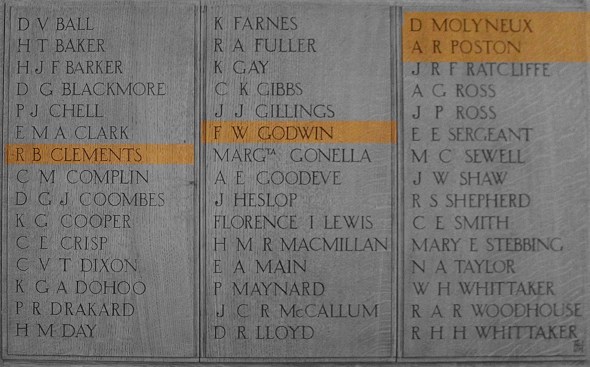
|
 | Arthur Roy Poston Joined the troop in May 1943 and was briefly Patrol Leader of the Kingfishers before joining the Etcetera's patrol for Scouts at bording school. He gained his 2nd class award in 1935 as well as Swimmer, Cyclist and Handyman. He went on to become a Lieutenant in the Westminster Dragoons.
Robert Whitaker Joined the troop in May 1934 and rose to become Acting PL of the Cuckoo patrol. Among others he gained his Swimmer and Athletes badges as well as a Royal Lifesaving Society Bronze Medallion through the Scouts. He died in February 1941 while on duty with the RAF. He was 19 years old.
Wilfred Nicholass was of course the first official Scout Leader at St Michaels back in the 1st Gidea Park days but stepped down when he was only offered an ASM title when we became a group in our own right. |
|
|
Reg Clements and David Lloyd may have been St Michael's Scouts in the 1st Gidea Park days as they don't appear to be in the group register of members and looking at thair investatue dates, it would have pre dated group registration.
Decorations for Gallantry
The 1946 annual report also lists two ex 3GP Scouts who had been awarded decorations for Gallantry In Battle by H.M the King.
- Squadron-Leader Cecil Caldwell Distinguished Flying Cross and Distinguished Flying Medal for skill & gallantry in Navigation, Bomber Command. He was a Scout from 1935 until 1939.
- Major Ronald Apps, 11th Punjab Regiment. Military Cross and bar to the Military Cross for gallantry in Burma. Ronald was a Scout from 1935-1938.
Mr Rowswell's Outline of the History of 3rd Gidea Park also mentions the following.
- Dennis Cotter D.F.C Scout 1934-35.
The 1946 annual report also lists ex Scouts who had moved on to take leadership warrants in other groups. Ivor Barden who was a Scout between 1938 and 1945 had become Assistant Scout Leader of the 2nd Odiham Troop in Hampshire. Alan Davies who was a Scout between 1942 and 1944 was now an assistant Cub Leader of the 1st Emerson park which was about to become a Squirrels Heath Group.
Within just a few months of moving meetings back to St Michael's Church the troop was back up to 40 Scouts, half of whom were over the age of 14. We had 18 Second class Scouts and 7 first class plus an 8th who was now in the services. Two of the first class Scouts were King's Scouts - Ray Dallas and Tony Smith.
The troop held Christmas-season hikes to Chigwell and Stanford Rivers. The annual report note that "These prove Essex to be as lonely a county as the Black Mountains, only three other travellers being encountered in twelve miles." Summer camp that year had been in the Black Mountains.
A regular Scout's own service in the form of a weekly bible class had been instituted every Sunday and at times attendance exceeded the accommodation.
During 1946 a patrol tent and rubber dingy had been purchased. As of January 1947, subs would be put up to 8d (old pence) per month which is approximately £1.20 in 2020 prices. |
|
|
 |
 |
|
 |
 |
 |
1947 |
|
|
The Group Annual report for 1947 notes that the Scouts now have six patrols of seven members making a total of 42 Scouts, 18 of whom were 2nd class and 12 were 1st class. The proportion of 1st class Scouts was 30 percent of the invested membership against a county average of just 5% Half of the troop were over 14 years of age.
During the year John Paisley gained the new (1947) Scout Cord, the first in the District and Raymon Dallas won the first Venturer badge which gained him the new Bushman’s Thong. At that time, only five Scouts in Romford District had ever gained a Bushman’s Thong and two of those were from 3rd Gidea Park.
Four members of the Troop were members of the British Contingent to the World Scout Jamboree in France. This was apparently the most from any single troop in the country. The four Scouts in question were Brian Lloyd, Neville Simmons, John Paisley and the Troop Leader, Ramon Dallas.
The annual report explains that 3GP and Brentwood School had collectively taken over a lease on a campsite at Navestock Vicarage from Brentwood District. Senior patrols did a lot of renovation work at weekends. The site included a hut. At Whitson the troop took part in a County camp at Danbury where the Scouts met the Chief Scout, Lord Rowallan.
Regular Saturday afternoon meetings were held at Brentwood School where elaborate pioneering projects could be completed. In 1947 we won the Dyer Cup for the first time and it was presented to us by Alderman Dyer.
Peter Davey one of our former Kings Scouts returned to 3GP as an assistant Scout Master along with Derek Leggett.
As well as the lease of the Navestock campsite, the group spent money on a cine camera.
During the year, members of the Cookoo patrol made a plaster cast of a badger footprint found within in the boundary of Romford Borough. Badgers were thought to be exstinct in Essex since before the 2nd World War. Months later the local press reported the shooting of a badger which confirmed our finding. |
|
|
 |
 |
|
 |
 |
 |
1948 |
|
|
During 1948 3rd Gidea Park Scouts were invited to Brentwood School for a personal visit by the Chief Scout Lord Rowallan. By all accounts he was impressed by the number of 1st class Scouts and Royal Life Saving Society badges.
|

|
The Chief Scout at Brentwood School. 3GP Scouts can be seen on the right. |
|
|
Finally in 1948 an old Scout, A.M. "Tony" Smith (the troops first post war King Scout) returned from the forces and became an Assistant Scout Master (First Mate). However later in the year Joy Langmaid married Mr A Warwick Child (who was ACC of Sussex) and moved away at which point Mr Tony Smith became our cubmaster. Also in 1948 Ted Butcher was released from the forces and resumed his ASM warrant as (Bo’sun)
Due to so many boys wanting to join the troop the entrance standard was raised. Boys wanting to join 3GP needed to be able to swim or at least take regular lessons. The number of first class Scouts had gone up to 17 making them 40 percent of the troop. John Paisley had gained his King’s Scout and Bushman’s Thong.
The September 1948 parish magazine contains an account of the summer camp. It includes a description of a hike up Goat Fell (874m) from the summit of which the Scouts could see Antrim and Donegal in Island. , The Scottish islands of Jura and Mull, Ben Lawers near Loch Tay, Skiddaw in the lake district and the Isle of Man. Brian Lloyd and Bruce Parker camped the night on the top.
The annual report for the year ends with a note stating that the following year we intended to visit Switzerland.
The Romford District annual report for the year ending March 31st 1948 contains a summary of the district census. Of the 350 Cubs in the sixteen packs in the district, 10% were members of 3rd Gidea Park. Of the 361 Scouts 10% were members of 3rd Gidea Park.
|
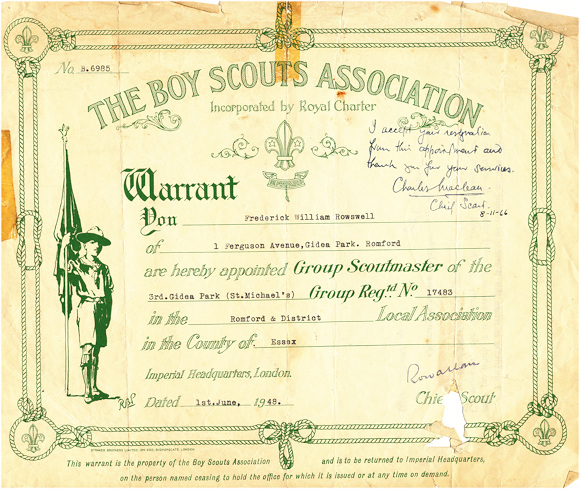 |
|
In June 1948 F.W.Rowswell was finally issued with a Warrant for the role of Group Scoutmaster a 3rd Gidea Park, a role he had been effectively fulfilling for fifteen years since 1933.
|
|
|
 |
 |
|
 |
 |
 |
1949 |
|
|
By 1949, Ray Dallas was leading the Rover Crew holding the position of Rover Mate as well as being a Scouter of a troop at Chigwell Row.
The Scout Troop consisted of 7 patrols including the elite Cobra patrol of older Scouts. We had 44 invested Scouts, 24 of which were over 14. 22 Were first class Scouts, 4 held the Scout Cord and 15 were second class. The vast majority of the 44 Scouts completed over 20 nights away during the year, at times camps were run in different places concurrently so while some Scouts were in Switzerland in April, others were at Navestock.
The Pack consisted of 36 cubs and was joined by two new Cub Instructors, P. Wall (Bagheera) and D. Jones (Baloo).
During the year Mr Rowswell represented The Scout Association at a reception given by the British Council to the Argentine and Uruguay educational delegation to the UK. He also notes in the annual report that he had discovered that he was now the only UK Scout corresponding with surviving Scouts in Hungary and Spain. Scouting in Hungary had been banned by the Hungarian Communist Party in 1946 It wasn’t until 1989 that Scouting re-started properly in Hungary but in 1949 Mr Rowswell was corresponding with the ex national commissioner for Hungarian Scouts who was by then living in Czecho-Slovakia. He was also corresponding with the ex-chief Scout of Spain. Scouting was banned in Spain in 1938 according to the Ministerial Decree of the Franco Government. By 1949 Spain was isolated by many European countries for not remaining as neutral as it claimed during the 2nd World. As Mr Rowswell put it, his correspondence was penetrating two iron curtains in the once so extensive Scouting world. |
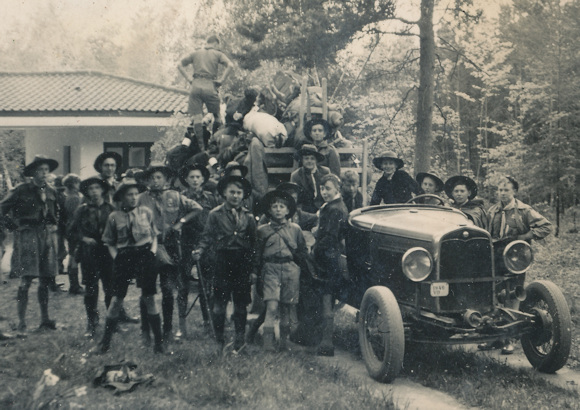 |
|
The above picture was taken as we left Buchillon at the end of our April 1949 camp in Switserland.
|
|
The local papers in April 1949 contained a lengthy account of our first camp on the continent since the second world war. We travelled as usual by train to Buchillon on Lake Geneva where we camped in a private woodland belonging to a villa with its own boat house.
The Scouts were suprised to find food shops in Switserland fully stocked unlike shops back home.
The summer camp was on the Isle of White at Shalfleet. Several Scouts swam the mile to the Solent and back. And a 25 mile overnight hike took place with Scouts sleeping under the stars. Some Scouts enjoyed it so much they carrid on for a second night and an additional 25 miles.
On June 25th both the Cubs and the Scouts won the District Sports trophies. This despite about half the troop being at School Speech days and so unable to take part. The Scouts won with 49 and a half points to 12th Romford's 24 and a half.
By the end of the 1940's the troop had survived its nomadic existence during the war, losing its meeting place. It had rebuilt the skills of its membership and re-established 3GPs reputation for quality camping, Scouting skills and foreign travel. The following decade would see that reputation go from strength to strength.
|
|
|
 |
 |
|
 |
|










































